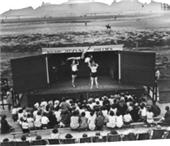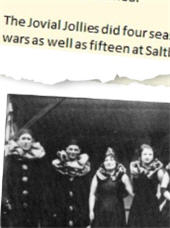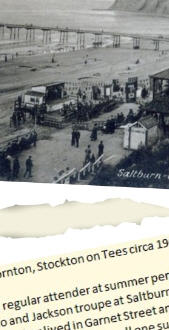Discovering the Pierrots at Saltburn by the Sea.
Pierrot • noun a male character in French pantomime, with a sad white-painted face, a loose white costume, and a pointed hat.
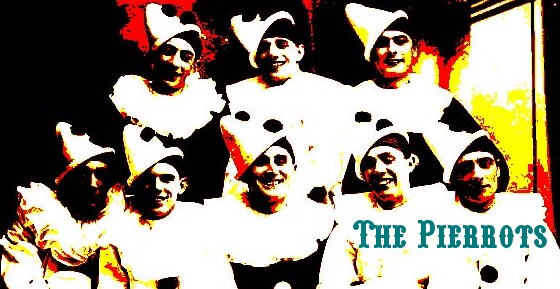
At the beginning of the Victorian era seaside holidays were a luxury confined to the rich and fashionable. Industrial expansion meant that the middle classes could also begin to enjoy a share of the Nation’s prosperity. The development of the railway system opened up the facility to travel to coastal resorts; consequently seaside holidays became a regular feature in the lives of middle class families and their households who would rent a large house for the summer season at a resort nearby. Servants found themselves with more free time during the week than they would normally expect in the home residence so they too had time when they could enjoy the diverse entertainments available to the holidaymakers. The railway companies also introduced cheap day excursions which became extremely popular with the workers in the towns and industrial cities, especially in the north of England. Visitors of all classes were eager for entertainment to enhance the enjoyment of their visit. As well as the usual array of street performers which included jugglers, barrel organists, tumblers and Punch and Judy shows this period saw the establishment of the first resident seaside entertainers. By the 1860’s most resorts had a ‘Minstrel Show’. Introduced from America, the ‘blackface' minstrels were all male troupes of extremely accomplished instrumentalists and singers whose faces were blackened with the aid of burnt cork. For almost three decades the minstrels dominated the beaches of the popular resorts until, in the 1890’s, a challenge came from the ‘pierrots’ who were to form the basis of seaside entertainment for the next fifty years.
'Blackface' minstrels.
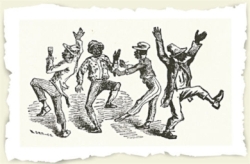 'Blackface' or burnt cork (used to create the black face) minstrelsy was introduced from America
in the mid-nineteenth century, initially through solo performances in music hall programmes, but
it rapidly evolved as a company form with it's own set of conventions. A show usually consisted of three
or four sections beginning with comic exchanges between some of the performers followed by musical
presentations of operatic numbers or plantation songs. Then came the 'variety show' where the
skills of tumbling, singing, dancing, skits, tricks, etc. were demonstrated. The 'afterpiece' was
often a comic monologue or 'Stump Speech' on current affairs before the final section,
the 'walkaround', which generally consisted of singing, both solo and choral. The performances were
successful in a wide range of venues but were especially famous as seaside entertainment.
'Blackface' or burnt cork (used to create the black face) minstrelsy was introduced from America
in the mid-nineteenth century, initially through solo performances in music hall programmes, but
it rapidly evolved as a company form with it's own set of conventions. A show usually consisted of three
or four sections beginning with comic exchanges between some of the performers followed by musical
presentations of operatic numbers or plantation songs. Then came the 'variety show' where the
skills of tumbling, singing, dancing, skits, tricks, etc. were demonstrated. The 'afterpiece' was
often a comic monologue or 'Stump Speech' on current affairs before the final section,
the 'walkaround', which generally consisted of singing, both solo and choral. The performances were
successful in a wide range of venues but were especially famous as seaside entertainment.
The early minstrel troupes would set up a circle of low boards, similar to a circus ring, on the sands. The audience gathered outside the ring and at suitable moments a member of the troupe would go round collecting money in a bottle - hence the term 'bottling'. The bottle - used because it is hard to remove money from a bottle - would be broken after a performance in front of the whole troupe.
At the turn of the century the minstrels were almost completely ousted in the seaside resorts by the pierrot shows. While many troupes disappeared, a number of troupes actually transmuted their performances and became 'whitefaced' pierrots. In Saltburn in the 1890's the Whitby troupe 'Mulvana's Minstrels' were hugely popular with visitors to the resort. Three of the original troupe - Bert Grapho, Billy Jackson and Phil Rees - later returned to perform successfully as pierrots.
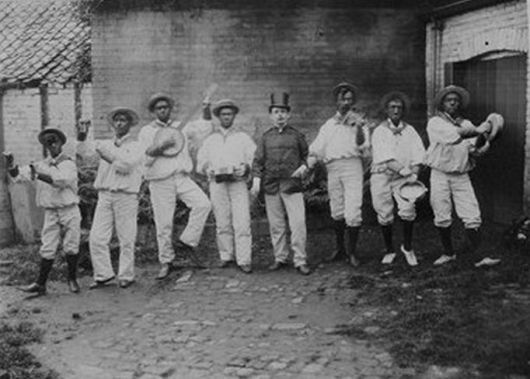
Mulvana's Minstrels, the Whitby troupe which visited Saltburn in the 1890's.
Left to right; Joseph Mulvana, Arthur Butler (The Silver Tenor), Unknown, Unknown, Henry James Mulvana, Unknown, Unknown, Unknown. ©Stephanie Gilbert
Commedia dell'arte
An essential part of every late Victorian and early Edwardian seaside resort’s entertainment the pierrots were buffoon figures who wore long sleeved white robes. The beginnings of the seaside pierrot troupe stemmed from the tradition of the commedia dell’ arte as performed in Italian fairground sideshows, circuses and theatres since the sixteenth century. The commedia was characterized by improvised performance based around set scenarios and popular characters. The routines incorporated singing, dance, music and acrobatics, comedy and drama, performed by itinerant groups on makeshift stages. They were particularly popular for their subversive and discerning insights on society, human foibles and universal themes such as love, jealousy and old age. One of the stock characters to emerge from the commedia tradition was that of Pedrolino, a peasant figure, who wore loose fitting white trousers and a smock. Generally hopelessly in love with a beautiful but fickle woman he had a sharp wit and a childlike capacity for laughter and tears, and was often an unwitting victim of the tricks of his fellows.
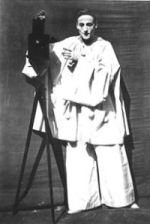 During the eighteenth century the genre of the commedia dell’arte moved with its travelling performers
through Europe and merged with a new art form, that of silent French pantomime. Many of the characters also
made the transition becoming new, but recognisable reincarnations. Arlecchino became the mad trickster
Harlequin, identified by his colourful, diamond patterned suit. The foolish Pedrolino, sometimes also
called Piero (Little Peter), gradually evolved into the French character of Pierrot, an innocent lovesick
dreamer. The creation of the definitive pierrot look is accredited to mime artist Jean-Gaspard Deburau
(1796-1846) who performed his silent act in Paris in the early nineteenth century. In his white smock and
pantaloons with a face whitened with flour and a black skull cap he established Pierrot as a lovesick,
silently suffering clown. Essentially a comic character provoking the audience to laughter, Pierrot
simultaneously incites sympathy and pity with his hapless antics, lovelorn countenance and melancholic air.
During the eighteenth century the genre of the commedia dell’arte moved with its travelling performers
through Europe and merged with a new art form, that of silent French pantomime. Many of the characters also
made the transition becoming new, but recognisable reincarnations. Arlecchino became the mad trickster
Harlequin, identified by his colourful, diamond patterned suit. The foolish Pedrolino, sometimes also
called Piero (Little Peter), gradually evolved into the French character of Pierrot, an innocent lovesick
dreamer. The creation of the definitive pierrot look is accredited to mime artist Jean-Gaspard Deburau
(1796-1846) who performed his silent act in Paris in the early nineteenth century. In his white smock and
pantaloons with a face whitened with flour and a black skull cap he established Pierrot as a lovesick,
silently suffering clown. Essentially a comic character provoking the audience to laughter, Pierrot
simultaneously incites sympathy and pity with his hapless antics, lovelorn countenance and melancholic air.
'Under the pier if wet!'
Pierrot groups first appeared in Britain's coastal resorts during the 1890s after being instituted by a singer and banjoist, Clifford Essex. He established the first pierrot group after a visit to France in 1891 having been struck with the appearance of traditional pierrots of French pantomime. The Pierrots quickly took-over from the ‘Minstrels’ and seaside resorts would soon boast of 3, 4 or even 5 different pierrot troupes all vying with one another for the favour and attention of the holidaymakers. There were other attractions, of course, but between 1890 and 1930, there were over 500 professional troupes working the seaside. They became an established feature of seaside entertainment until the Second World War.
The pierrot shows comprised numerous 'turns' which varied from troupe to troupe, depending on the talents of it's members. Audiences could enjoy songs, instrumental turns, comic backchat and sketches, dancing and displays of particular skills, such a juggling. Generally troupes were based in particular resorts, returning each summer season to perform on the sands or promenade - weather permitting. (It is reported that in 1912 huge freak waves soaked both the audience and the performers of the Redcar Follies.)
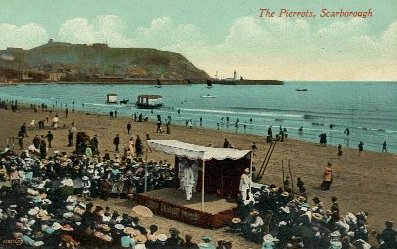 Originally each troupe occupied its own ‘pitch’ on the beach. Some troupes laid down boards,
others performed directly on the sand itself. As they became more popular they built and performed
on a portable wooden stage, usually erected directly on the beach. Members of the audience seated
in deck chairs were asked to pay a nominal fee to watch the act. Although pierrot routines shared
some common features with those of the urban music-hall such as comic sketches, dancing and popular
songs, their material tended to be less risqué, offering instead hearty family entertainment.
Originally each troupe occupied its own ‘pitch’ on the beach. Some troupes laid down boards,
others performed directly on the sand itself. As they became more popular they built and performed
on a portable wooden stage, usually erected directly on the beach. Members of the audience seated
in deck chairs were asked to pay a nominal fee to watch the act. Although pierrot routines shared
some common features with those of the urban music-hall such as comic sketches, dancing and popular
songs, their material tended to be less risqué, offering instead hearty family entertainment.
Early troupes wore costumes derived from the pierrot character of French pantomime, typically loose pantaloons and tunics with ruffles around the neck, big black buttons or pom poms and a conical shaped hat. By the beginning of the twentieth century it became common for pierrots to incorporate contemporary clothes into the second half of their act such as evening dress with top hat, or blazers and boaters.
Will Catlin, who began in Scarborough, is often called the 'King of the Pierrots', being one of the most famous of several pierrot entrepreneurs. Catlin insisted that his troupes were all-male, encouraging them to present themselves as bachelors although many were married. Catlin was also the first to have postcards of his troupe printed and available for sale.
Although Catlin insisted on all-male troupes, many companies had women performers. In 1899 Bert Grapho's 'Jovial Jollies' at Saltburn contained at least four female performers.
Pierrot troupes regularly gave up to four shows a day, often in adverse conditions. Without the comforts of the theatre dressing room they faced all the elements, blazing sunshine or pouring rain with good humour and fortitude.
Saltburn by the Sea, with its clean, bracing air and miles of golden sands, was much favoured by the residents of the industrial towns and cities of the north. The firm sandy beach was ideal for the early alfresco and later stage performances of the pierrots. The pier itself provided shelter for the pierrots on numerous occasions. Undeterred by the weather they performed ‘under the pier if wet!’
In 1925 a theatre was built on the pier as an added attraction and a band was usually engaged for the season. Other entertainments included acrobats, jugglers and performing animals. Another popular feature was the firework display which marked the annual opening of the Pleasure Gardens for the holiday season. Saltburn also offered excellent accommodation for all kinds of visitors.
One of the earliest troupes of seaside entertainers on the sands of Saltburn was Little Tommy’s troupe of black-faced minstrels who performed near the cliff lift. John Middleton is credited with presenting the first pierrot troupe on the sands at Saltburn but he soon sold out to Bert Grapho and in the summer of 1899 Saltburn visitors were entertained for the first time by Grapho and Jackson’s early troupe of pierrots. This was to be the beginning of a forty year association with the town which ended in 1939 by the outbreak of the Second World War.
In the early days the ‘Jovial Jollies’ performed on boards laid on the sands, there were no changing facilities and two bathing tents were used as ‘changing rooms’. Eventually they had an alfresco pitch on the lower promenade. There were deckchairs for the patrons and forms for the children placed directly in front of the stage. The price of a seat was one penny. Like performers in other towns, the Jovial Jollies were charged a fee for the pitch. Town records show that in 1901 they paid a fee of £10 for the season. Of course when the council realised their potential the fees began to rise. By 1906 it had risen to £50, and as the years passed the troupes were asked for ever increasing amounts. In time the council agreed that the ‘Jollies’ could, during the month of August, the peak of the holiday season, give their evening shows in the bandstand in Hazel Grove Gardens. Fairy Lights, strung up in the trees, added to the carnival atmosphere which pervaded the shows on warm summer evenings.
In the halcyon days of the thirties, after the lean days of unemployment in the twenties, times became more prosperous in the years leading up to the war. Holidays for the working classes were now a reality and the pierrots worked extremely hard at their three shows a day in accordance with tides and weather. They lived in a large house on the Top Promenade, and the high spot of the day for many a child was to accompany the pierrots either up or down the winding cliff paths between performances. Finally the outbreak of the Second World War saw the end of the pierrots in Saltburn as well as in many other resorts. Inevitably post war audiences began to demand more sophistication in the shows they watched and eventually the concert parties began to perform in the pier theatres and Floral Halls. These concerts were the forerunners of today's spectacular summer shows.
The pierrot troupes were hard working and dedicated, giving their best to entertain everyone, often for a meagre financial return and it is a sad reflection on our times that the stalwart performers of those alfresco seaside shows have been sadly neglected and almost forgotten.
Research by Rebecca Hilton. Collecting primary source materials, articles and extracts from books related to the development of both Saltburn's and trying to validate them has offered conflicting information, much of which is often difficult to validate as many sources can prove to be unreliable e.g. newspapers or census data. Every effort has been made to ensure that the information on the history of the town presented here is as accurate as possible.

